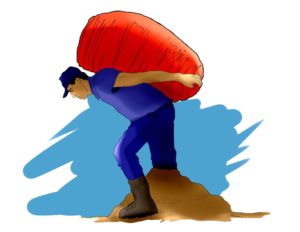
It is possible to define the physical load of the work as the set of physical requests to which the person turns out to be submitted along its working day. These requests bear a series of efforts on the part of the worker that will suppose a major energy consumption major all that is the effort. To this energy consumption it is named a work metabolism.
We say that a work has physical load when the type of activity needed by the task is principally physical or muscular.
Dynamic physical load
Certain physical demands, like walking or running, force that the muscle contracts (shorten) and stretch (lengthen) rhythmically. To this type of muscular contraction it is named isotónica. The work or realized exercise receives the name of dynamic.
Examples:
– to walk: dynamic work for the muscles of the low extremities.
– to raise a weight of a table: dynamic work for the upper extremities.
Static physical load
In other occasions, the muscle must contract and maintain the contraction during a variable time. This is what happens when we maintain a force (supporting a weight, for example) or a certain position. To this type of contraction it is named isometric and to the work or derivative, static exercise.
Examples:
– To support a weight in arms several minutes: Static work for these muscles.
– To maintain the trunk in the same position several minutes: Static work of the trunk.
In principle, a dynamic work can be realized for hours, whenever it is executed to a rhythm adapted to the person and to the effort and this one is not of excessive intensity. Also, the rhythmic contraction of the muscle favors the blood irrigation to the area that works.
Nevertheless, during the static work, the long contraction of the muscle compresses the blood glasses provoking a less blood contribution the carried away muscle (and to the bones and joints of the area), so that there comes a less quantity of nutrients and oxygen, necessary for the muscular work. This causes the appearance of the muscular fatigue, which limits the maintenance of the contraction
Muscular fatigue
The muscular fatigue is evident with such signs like: heat sensation in the area of the muscle, muscular quakes, sensation of pins and needles or enclosed muscular pain.
The muscular fatigue is a process physiological that it affects to the muscle or muscles involved in the effort and recovers with the rest of the same ones. If this rest is not realized or is insufficient for the recovery of the muscular fatigue, disorders can go so far as to develop musculoesqueléticos.
Another effect derived from the static work is the increase of the cardiac frequency, since the heart must get drunk more quickly to try to send more oxygen and nutrients to the carried away muscle. For it, one has raised that the static work might be a factor of risk of illnesses of the heart or cardiopatías.
Disorders musculoesqueleticos
The disorders musculoesqueléticos (TME) are one of the illnesses of labor origin more common that affect million workpeople in the whole Europe and cost to the businessmen thousands of million euros. To confront the TME helps to improve the lives of the workpeople although also it makes sense from a managerial point of view.
The disorders musculoesqueléticos normally affect to the back, neck, shoulders and upper extremities, although also they can affect to the low extremities. They understand any damage or disorder of the joints and other textiles. The problems of health include from small inconveniences and pains to medical pictures more serious that force to request the labor fall and even to receive medical treatment. In the most chronic cases, they can give as turned out a disability and the need to stop working.
Two main groups of TME are the pains and the injuries of back and the labor disorders of the upper extremities (that are known commonly as injuries for repetitive movements).
Causes of the TME
Most of the TME related to the work develop over the course of time. Normally there is no only cause of the TME, but there are different the factors that work jointly. Between the physical causes and the factors of organizational risks are included:
– charges manipulation, especially on having stooped and to be turned
– repetitive or forced movements
– strange or static positions
– vibrations, deficient lighting or cold environments of work
– work to a high rhythm
– to be standing up or sit for the long time in the same position
You exist increasing information that link the disorders musculoesqueléticos with factors of psychosocial risk (especially combined with physical risks), between which they are included:
– high level of demand of work or a scarce autonomy
– scarce labor satisfaction
Prevention:
The only solution does not exist and in case of serious or slightly habitual problems professional advice can be necessary. Nevertheless, many solutions are easy and cheap, for example, to provide a barrow to manipulate goods or to change the position of the elements of an office.
To tackle the disorders musculoesqueléticos the businessmen should use a combination of:
Risk assessment: to adopt an approach holístico, evaluating and tackling all the causes
Participation of the employee: to include to the personnel and its representatives in the debates on possible problems and solutions.





